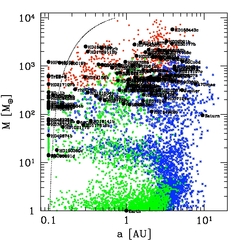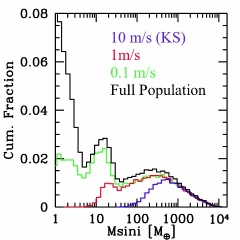Planetary population synthesis
Contact: C. Mordasini, K. Dittkrist, H. Klahr, T. Henning, Y. Alibert (University of Bern), W. Benz (University of Bern and external scientific member MPIA)
Planetary population synthesis is a method to understand the statistical properties of extrasolar planets, and the influence of disk properties on them. The research field of extrasolar planets has seen a very impressive growth in the past ten years, mostly driven by an ever increasing detection rate of planets around other stars. These planets were found to often exhibit properties very distinct from those in our own solar system, and seriously challenged theoretical models. Nowadays, we understand this diversity as a consequence of the diversity of the environment where planets form, i.e. as a consequence of the diversity of the properties of protoplanetary disks. Also for this latter class of astrophysical objects, our understanding has grown a lot in the last ten years.
Population synthesis provides the link beween these two groups of observational data: By deriving distributions of initial conditions from observations of protoplanetary disks, and a planetary formation model, one can generate a population of synthetic extrasolar planets. The statistical properties of these synthetic planets are then compared with the observed ones. In this way, one can both constrain and improve formation models, as well as understand correlations between disk and planetary properties. One can also make predictions about those planets that are currently beyond the capabilities of our search methods. Our current work focusses on understanding disk-planet correlations, on extending our results on other detection methods than radial velocity, and on studying the global effects of setting in the formation model.
 The figure shows the mass-distance plane of actual extrasolar planets (black, with names) and of synthetic planets. For the latter, the color coding depends on the internal composition of the planet.
The figure shows the mass-distance plane of actual extrasolar planets (black, with names) and of synthetic planets. For the latter, the color coding depends on the internal composition of the planet.
 The plot shows the predicted planetary initial mass function around solar mass stars. Several minima and maxima can be seen, in particular a strong raise at the smallest masses. The black line shows the distribution of the full synthetic population. Colored lines give the mass distribution of planets that can be discovered by the radial velocity method with an instrument of the accuracy indicated in the plot. The higher the accuracy, the more we approach the underlying full distribution. Note that at a precision of 1 m/s like the HARPS spectrometer, the distribution becomes bimodal.
The plot shows the predicted planetary initial mass function around solar mass stars. Several minima and maxima can be seen, in particular a strong raise at the smallest masses. The black line shows the distribution of the full synthetic population. Colored lines give the mass distribution of planets that can be discovered by the radial velocity method with an instrument of the accuracy indicated in the plot. The higher the accuracy, the more we approach the underlying full distribution. Note that at a precision of 1 m/s like the HARPS spectrometer, the distribution becomes bimodal.

